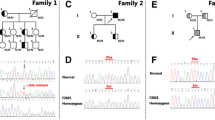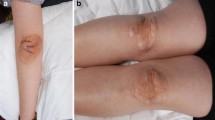Abstract
Familial hypercholesterolaemia (FH) is an autosomal dominant disorder of lipid metabolism characterized by elevated low-density lipoproteins (LDL), the formation of tendon and skin xanthomata and the development of premature coronary atherosclerosis. It is caused by a defect in the receptor-mediated hepatic uptake of LDL due to mutations in the LDL receptor. In 25 FH families with a total of 160 members and in two individuals without available relatives, all of German origin, we identified LDL receptor mutations by a multiplex-PCR-based single-strand conformation polymorphism method followed by direct sequencing. Of the 24 mutations found, 15 are missense mutations, 2 are nonsense mutations, 4 are small deletions or insertions leading to frameshifts, 2 are an in-frame insertion and deletion, respectively, and one is a splice site mutation. Propositi carrying mutations that are known to completely abolish receptor function (nonsense and frameshift mutations, missense mutation V480M) had significantly higher untreated total and LDL-cholesterol levels compared to those patients carrying missense and in-frame insertion mutations of unknown functional consequence, which may lead to either reduced or completely abolished receptor function (11.30±1.64 vs 9.76±1.50 mmol/L, and 9.39±1.23 vs 7.99±1.45 mmol/L, respectively). These results confirm the clinical and molecular heterogeneity of FH and the influence of different functional classes of mutations on lipid values.
Similar content being viewed by others
REFERENCES
Ahn YI, Kamboh MI, Aston CE, et al (1994) Role of common genetic polymorphisms in the LDL receptor gene in affecting plasma cholesterol levels in the general population. Arterioscler Thromb 14: 663–670.
Bertolini S, Garuti R, Lelli W, et al (1995) Four novel partial deletions of LDL-receptor gene in Italian patients with familial hypercholesterolemia. Arterioscler Thromb Vasc Biol 15: 81–88.
Betard C, Kessling AM, Roy M, et al (1996) Influuence of genetic variability in the nondeletion LDL-receptor allele on phenotypic variation in French-Canadian familial hypercholesterolemia heterozygotes sharing a ‘null’ LDL-receptor gene defect. Atherosclerosis 119: 43–55.
Cambien F, Costerousse O, Tiret L, et al (1994) Plasma level and gene polymorphism of angiotensin-converting enzyme in relation to myocardial infarction. Circulation 90: 669–676.
Day IN, Whittall RA, O'Dell SD, et al (1997) Spectrum of LDL receptor gene mutations in heterozygous familial hypercholesterolemia. Hum Mutat 10: 116–127.
Defesche JC, van-Diermen DE, Lansberg PJ, et al (1993) South African founder mutations in the low-density lipoprotein receptor gene causing familial hypercholesterolemia in the Dutch population. Hum Genet 92: 567–570.
Ekstrom U, Abrahamson M, Sveger T, et al (1995) An efficient screening procedure detecting six novel mutations in the LDL receptor gene in Swedish children with hypercholesterolemia. Hum Genet 96: 147–150.
Esser V, Russell DW (1988) Transport-deficient mutations in the low density lipoprotein receptor. Alterations in the cysteine-rich and cysteine-poor regions of the protein block intracellular transport. J Biol Chem 263: 13276–13281.
Gaudet D, Voh lMC, Couture P, et al (1999) Contribution of receptor negative versus receptor defective mutations in the LDL-receptor gene to angiographically assessed coronary artery disease among young (25–49 years) versus middle-aged (50–64 years) men. Atherosclerosis 143: 153–161.
Geisel J, Holzem G, Oette K (1995) Screening for mutations in exon 4 of the LDL receptor gene in a German population with severe hypercholesterolemia. Hum Genet 96: 301–304.
Goldstein JL, Hobbs HH, Brown MS (1995) Familial hypercholesterolemia. In Scriver CR, Beaudet AL, Sly WS, Valle D, eds. TheMetabolic andMolecular Bases of InheritedDisease, 7th edn. New York: McGraw-Hill, 1981–2030.
Gudnason V, King-Underwood L, Seed M, et al (1993) Identification of recurrent and novel mutations in exon 4 of the LDL receptor gene in patients with familial hypercholesterolemia in the United Kingdom. Arterioscler Thromb 13: 56–63.
Gudnason V, Day INM, Humphries SE (1994) Effect on plasma lipid levels of different classes of mutations in the low-density-lipoprotein receptor gene in patients with familial hypercholesterolemia. Arterioscler Thromb 14: 1717–1722.
Hill JS, Hayden MR, Frohlich J, et al (1991) The incidence of coronary artery disease in heterozygous familial hypercholesterolemia. Arterioscler Thromb 11: 290–297.
Hobbs HH, Brown MS, Goldstein JL (1992) Molecular genetics of the LDL receptor gene in familial hypercholesterolemia. Hum Mutat 1: 445–466.
Jensen HK, Jensen TG, Jensen LG, et al (1994) Characterization of a disease-causing Glu119-Lys mutation in the low-density lipoprotein receptor gene in two Danish families with heterozygous familial hypercholesterolemia. Hum Mutat 4: 102–113.
Kotze MJ, Langenhoven E, Warnich L, et al (1989) The identification of two low-density lipoprotein receptor gene mutations in South African familial hypercholesterolemia. S Afr Med J 76: 399–401.
Kotze MJ, De-Villiers WJ, Steyn K, et al (1993) Phenotypic variation among familial hypercholesterolemics heterozygous for either one of two Afrikaner founder LDL receptor mutations. Arterioscler Thromb 13: 1460–1468.
Kunkel LM, Smith KD, Boyer SH, et al (1977) Analysis of human Y-chromosome-specific reiterated DNA in chromosome variants. Proc Natl Acad Sci USA 74: 1245–1249.
Leitersdorf E, Eisenberg S, Eliav O, et al (1993) Genetic determinants of responsiveness to the HMG-CoA reductase inhibitor fluvastatin in patients with molecularly defined hetero-zygous familial hypercholesterolemia. Circulation 87: III-35-III-44.
Lelli N, Ghisellini M, Gualdi R, et al (1991) Characterization of three mutations of the low density lipoprotein receptor gene in Italian patients with familial hypercholesterolemia. Arterioscler Thromb 11: 234–243.
Loux, N, Saint-Jore B, Collod G, et al (1992) Screening for newmutations in the LDL receptor gene in seven French familial hypercholesterolemia families by the single strand con-formation polymorphism method. Hum Mutat 1: 325–332.
Orita M, Iwahana H, Kanazawa H, et al (1989) Detection of polymorphisms of human DNA by gel electrophoresis as single-stranded conformation polymorphisms. Proc Natl Acad Sci USA 96: 2766–2770.
Pullinger CR, Hennessy LK, Chatterton JE, et al (1995) Familial ligand-defective apolipoprotein B. Identification of a new mutation that decreases LDL receptor binding affinity. J Clin Invest 95: 1225–1234.
Sanger F, Nicklen S, Coulson AR (1977) DNA sequencing with chain-terminating inhibitors. Proc Natl Acad Sci USA 74: 5463–5467.
Schuster H, Rauh G, Muller S, et al (1992) Allele-specific and asymmetric polymerase chain reaction amplification in combination: a one step polymerase chain reaction protocol for rapid diagnosis of familial defective apolipoprotein B-100. Anal Biochem 204: 22–25.
Schuster H, Keller C, Wolfram G, et al (1995) Ten LDL receptor mutants explain one-third of familial hypercholesterolemia in a German sample. Arterioscler Thromb Vasc Biol 15: 2176–2180.
Sheffield VC, Beck JS, Kwitek AE, et al (1993) The sensitivity of single-strand conformation polymorphism analysis for the detection of single base substitutions. Genomics 16: 325–332.
Soria LF, Ludwig EH, Clarke HR, et al (1989) Association between a specific apolipoprotein B mutation and familial defective apolipoprotein B-100. Proc Natl Acad Sci USA 86: 587–591.
Soutar AK, McCarthy SN, Seed M, et al (1991) Relationship between apolipoprotein(a) phenotype, lipoprotein(a) concentration in plasma, and low density lipoprotein receptor function in a large kindred with familial hypercholesterolemia due to the pro664→leu mutation in the LDL receptor gene. J Clin Invest 88: 483–492.
Stone NJ, Levy RI, Fredrickson DS, et al (1974) Coronary artery disease in 116 kindreds with familial type II hyperlipoproteinemia. Circulation 49: 474–488.
Sun XM, Patel DD, Knight BL, et al (1998) Influence of genotype at the low density lipoprotein (LDL) receptor gene locus on the clinical phenotype and response to lipid-lowering drug therapy in heterozygous familial hypercholesterolaemia. The Familial Hypercholesterolaemia Regression Study Group. Atherosclerosis 136: 175–185.
Thompson GR, Seed M, Niththyananthan S, et al (1989) Genotypic and phenotypic variation in familial hypercholesterolemia. Arteriosclerosis 9: 175–180.
Top B, Koeleman BP, Gevers-Leuven JA, et al (1990) Rearrangements in the LDL receptor gene in Dutch familial hypercholesterolemic patients and the presence of a common 4 kb deletion Atherosclerosis 83: 127–136.
Torres AL,Moorjani S, Vohl MC, et al (1996) Heterozygous familial hypercholesterolemia in children: low-density lipoprotein receptor mutational analysis and variation in the expression of plasma lipoprotein lipid concentrations. Atherosclerosis 126: 163–171.
Webb JC, Sun S-M, McCarthy SN, et al (1996) Characterization of mutations in the low density lipoprotein (LDL)-receptor gene in patients with homozygous familial hypercholesterolemia, and frequency of these mutations in FH patients in the United Kingdom. J Lipid Res 37: 368–381.
Weiss N, Eggersdorfer I, Keller C (1996) Multiplex-PCR based single-strand conformation polymorphism protocol for simultaneous analysis of up to five fragments of the low-density-lipoprotein receptor gene. Biotechniques 20: 421–429.
Williams RR, Hunt SC, Schumacher MC, et al (1993) Diagnosing heterozygous familial hypercholesterolemia using new practical criteria validated by molecular genetics. Am J Cardiol 72: 171–176.
Wilson DJ, Gahan M, Haddad L, et al (1998) A world wide website for LDLR gene mutations in FH: sequence-based, tabular, and direct submission data handling. Am J Cardiol 81: 1509–1511.
Author information
Authors and Affiliations
Rights and permissions
About this article
Cite this article
Weiss, N., Binder, G. & Keller, C. Mutations in the low-density-lipoprotein receptor gene in German patients with familial hypercholesterolaemia. J Inherit Metab Dis 23, 778–790 (2000). https://doi.org/10.1023/A:1026704517598
Issue Date:
DOI: https://doi.org/10.1023/A:1026704517598




